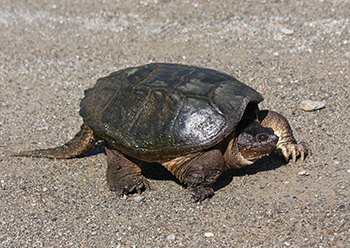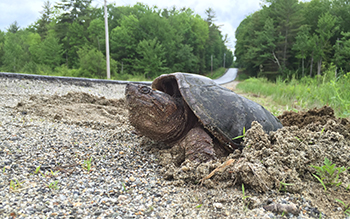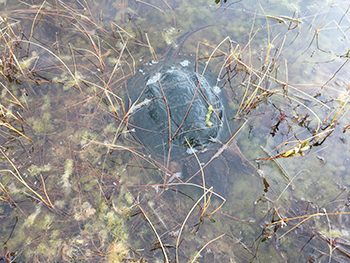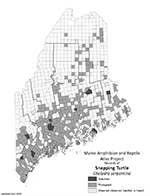Home → Fish & Wildlife → Wildlife → Species Information → Reptiles & Amphibians → Snapping Turtle
Snapping Turtle
Chelydra serpentina
On this page:

Photo: Trevor Persons
Distinguishing Characteristics

Photo: Trevor Persons
- Large, carapace (upper part of shell) approximately 8 to 14 inches in length
- Rough, blackish-brown shell with distinct grooves along back edge
- Narrow, T-shaped plastron (bottom part of shell)
- Very large head
- Long tail with saw-tooth ridges along upper surface
- Older turtles commonly harbor algae on their carapace and appear greenish-gray
Status and Distribution in Maine
- Common and secure
- Southern, central, eastern, and northern regions
Habitat

Photo: Trevor Persons
- All types of permanent aquatic habitats including ponds, lakes, rivers, bogs, marshes, and even brackish salt marshes
- Lays eggs in June in sandy soil, including gravel road shoulders; nests can be up to 1.9 miles from their home ponds
Diet
- Omnivorous. Eats fish, crayfish, aquatic invertebrates, reptiles, birds, mammals, and plants
Seasonal Changes
- Hibernates in the bottom sediments of lakes
Natural History Notes
- One of the most ancient living organisms, having evolved 60–100 million years ago
- Aggressive on land, but elusive and shy in water
Share Your Sighting
There is much still to learn about the distribution and ecology of Maine’s herpetofauna, and we encourage members of the public to share their photo-documented observations as part of the Maine Amphibian & Reptile Atlas Project (MARAP).
To see if a township still needs documentation of a species, consult this distribution map (PDF). If a township lacks a photo or specimen record, we want your observation!
There are two ways to share your observations:
Submit your reptile or amphibian observation online
No service? No problem. Click here to download the survey to your device while connected, then take offline to collect observations from anywhere. Tip: The survey works best on Google Chrome and Safari.
Or upload sightings to the iNaturalist citizen science project through their website at iNaturalist.org or mobile app.
- When submitting an observation through iNaturalist add a description of the location (and other noteworthy information) to the “notes” field. This serves as a check on the locations automatically generated by smartphone cameras, which may be imprecise if cell service or GPS coverage is weak.
Thank you for doing your part to help conserve Maine’s reptiles and amphibians.
